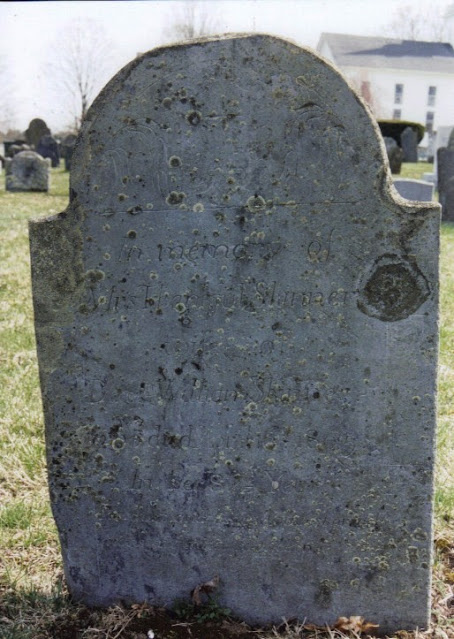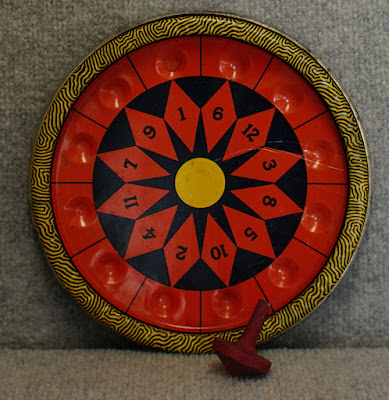A Truly Appropriate Name for a Hate-Filled Hypocritical
Puritan Zealot
Hatevil Nutter: Approx. 1603-1675
When I first ran across my tenth-great-grandfather Hatevil
Nutter, I was so fixated on his delightfully amusing surname, Nutter, that I
totally failed to recognize that his first name was a portmanteau—a single word
composed of two words. I first mistakenly pronounced it Hat’-eh-val—it took me
a while to realize that due to the erratic spelling used in the early 17th
century, his parents had dropped the now-standard silent “e” from the word
“hate” when they combined the words “hate” and “evil” into a bizarre Puritan
given name.
The combination of Hate Evil and Nutter is ridiculously
funny to a 21st century person like me. Sadly, my ancestor may truly
have been a “nutter”, for rather than fighting evil, he seems to have delighted
in stirring it up. Hatred for Quakers consumed him and led to persecution and violence
against those peaceful people, including attacks on female Quakers. In seventeenth
century New Hampshire, Hatevil was considered a godly man doing the Lord’s
work. His actions were accepted and even lauded by his fellow Puritan
colonists, while those same actions, viewed through the lens of the 21st
century, appear evil, sick and bigoted.
Hatevil Nutter was born in England sometime between 1598 and
1603. His parents may have been Edmund Nutter and his wife Jane Fulford, but
that information is based solely on public trees that provide no evidence or
documentation, and I have been unable to verify his origins.
Hatevil married Ann
Ayers in England sometime prior to 1630. She is said to have been born around
1608. The couple arrived in the colonies between 1633 and 1637, possibly with
their oldest son Antony who seems to have been born in England around 1630.
According to Mary Hanaford in her book cited below,
“Hatevil Nutter, an elder and preacher, was
born in 1603; he was one of a company induced to leave England with Captain Wiggin
in 1635, and to help found on Dover Neck, N. H., a "compact town' which
never went farther than High Street, & Dirty Lane; he received lots of
land, in different localities.”
 |
| Mouth of Piscatqua River in NH modern day |
Nutter was
one of a group of Puritans who founded the town of Dover—then Dover Neck—New
Hampshire. The group was described in one account as a "Company of persons
of good estate and of some account for religion". Hatevil
was very active in the Puritan church, attaining the title of “Elder”, which
meant he may have helped at church services and occasionally preached.
 |
| Dover Neck NH 1623-1723 |
He was also
a successful businessman with a variety of business pursuits. He appears in
records in the 1640s, giving a deposition at one point that detailed his land
acquisition from a John Wiggins, which included the following parcel: "Butting on ye Fore River, east; and on
ye west by High Street; on ye north by ye Lott of Samewell Haynes; and on ye
south by Lott of William Story."
John Scales described Hatevil and his business affairs as
follows in his book Piscataqua Pioneers:
“He was among the
noted men of the town, both in business and in church affairs. He was one of
the first Elders of the First Church, and held the office for life. Though not
given to much office holding, he received various valuable grants for saw mills
and trees for supplying his mills for sawing into lumber. He had a ship yard on
Fore River, and was largely engaged in ship building; his ships sailed all
along the coast and to the West Indies, with which islands Dover had much
trade.”
The shipping interests were probably the main source of his
wealth. The map below shows the various Dover area properties owned by Hatevil.
 |
| Map of Dover Neck area including Nutter house adn shipyard |
Hatevil and his wife had at least five children. In addition
to Antony, the family included John, Elizabeth, Abigail, and my ancestor, Mary.
The Puritans, despite coming to America to pursue religious
freedom, did not welcome or accept people of other faiths who also sought the
freedom to worship as they chose. When Quakers began visiting colonial
villages, attempting to gain converts, Puritan leaders reacted with anger and
cruelty. Hatevil was a prime example of this Puritanical hatred. In 1662, three
Quaker women, Ann Coleman, Mary Tompkins, and Alice Ambrose, arrived in Dover
and began preaching to the inhabitants. They openly argued with the minister of
the Puritan church, Rev. John Reynor.
This infuriated Hatevil. He organized a petition that was
sent to the colonial crown magistrate, "humbly craving relief against the
spreading & the wicked errors of the Quakers among them". The
magistrate issued the following order:
"To the constables of Dover, Hampton,
Salisbury, Newbury, Rowley, Ipswich, Wenham, Linn, Boston, Roxbury, Dedham, and
until these vagabond Quakers are carried out of this jurisdiction, you, and
every one of you are required in the name of the King's Majesty's name, to take
these vagabond Quakers, Ann Coleman, Mary Tompkins, and Alice Ambrose, and make
them fast to the cart's tail, and driving the cart through your several towns,
to whip their naked backs, not exceeding ten stripes apiece on each of them, in
each town; and so to convey them from constable to constable, till they are out
of this jurisdiction".
This was the middle of winter, and the towns in question
covered eighty miles. The women were expected to walk in the snow, dragged
along behind a cart, while bleeding. Not a very Christian action, but par for
the course in the Puritan colonies. Quakers were frequently executed or beaten
to death, so the plan to whip the women and drag them for miles through the
snow raised no immediate objections among the populace.
 |
| Engraving of Puritans whipping Quaker men at cart tail--1660s |
When the magistrate’s order came down, Hatevil roused his
son-in-aw, John Roberts (married to daughter Abigail), who was one of the
town’s constables, and had him capture the women, strip them to the waist, tie
them to a cart and whip them.
George Bishop described the events as follows:
"Deputy Waldron caused these women to
be stripped naked from the middle upwards, and tied to a cart, and after awhile
cruelly whipped them, whilst the priest stood and looked and laughed at
it."
It sounds as
if the men of Dover delighted in ogling the half-naked women. Even the
supposedly pious Rev. Reynor was laughing at the horrific sight.
The Quaker historian William Sewell blamed Hatevil for the
abuse.
"All this
whipping of the Quaker women, by the Constables (in front of the
meeting-house), was in the presence of one Hate-Evil Nutwell (Nutter), a Ruling
Elder, who stirred up the Constables (John and Thomas Roberts) to this wicked
action, as so proved that he bore a wrong name (Hate Evil)."
Fortunately for the three women, they were only tortured and
whipped in Dover and Hampton. When they were dragged into the town of
Salisbury, the local constable along with Major Robert Pike, the leading
military officer of the region, refused to enact the order. The women were
freed, received medical attention from a Dr. Barefoot, one of Nutter’s
neighbors, who had accompanied the cart from Dover. Pike sent the women to
Maine to recuperate, as Maine was not under Puritan control.
All of Hatevil’s efforts to stamp out Quakerism in Dover were
for naught. Within a matter of a few years, the Quakers returned to Dover,
converted over one third of the inhabitants, and built a Quaker meeting house,
probably within view of at least one of Hatevil’s many properties.
 |
| Nutter property in orange. Blue shows site of whipping and Puritan meeting house, with Dr. Barefoot's house at bottom, and Quaker meeting house at top. |
Hatevil died in 1675; he was about 71 years of age. Two of
his five children (John and Elizabeth) had preceded him in death, so his substantial
estate was divided amongst his wife Ann and the remaining three children,
including my ancestor Mary Nutter Wingate.
The given name “Hatevil” was passed down to at least two of
Hatevil’s grandsons: Hatevil Nutter, son of Antony Nutter, and Hatevil Roberts,
son of John and Abigail Nutter Roberts. Hopefully, those young men had hearts that
were open to love as well as hatred, and that they exhibited tolerance to those
of other faiths.
Hatevil Nutter and his bigotry live on in a poem by John
Greenleaf Whittier called “How the Women Went from Dover”. It begins as
follows:
The tossing spray of Cocheco's fall
Hardened to ice on its rocky wall,
As through Dover town in the chill, gray
dawn,
Three women passed, at the cart-tail drawn!
Bared to the waist, for the north wind's
grip
And keener sting of the constable's whip,
The blood that followed each hissing blow
Froze as it sprinkled the winter snow.
Priest and ruler, boy and maid
Followed the dismal cavalcade;
And from door and window, open thrown,
Looked and wondered gaffer and crone.
"God is our witness," the victims
cried,
"We suffer for Him who for all men died;
The wrong ye do has been done before,
We bear the stripes that the Master bore!
Further on,
Hatevil is immortalized in this verse:
"Smite, Goodman Hate - Evil!-harder
still!"
The magistrate cried, "lay on with a
will!
Drive out of their bodies the Father of
Lies,
Who through them preaches and prophesies!"
This act of
cruelty was a sad legacy to leave. Perhaps Hatevil’s name should be unpacked
from its portmanteau form into the original two words, but separated by periods:
Hate. Evil. Nutter. For after all, he seems to have been a nut job filled with
hate and evil.
 |
| Dover Neck area today--satellite view |
Sources:
Hatevil Nutter of
Dover, New Hampshire and his descendants, by Boyle, Frederick.
Publication date 1997. Publisher Portsmouth, NH : Peter E. Randall
Publisher. Pages 3-7.
https://www.newenglandhistoricalsociety.com/1662-robert-pike-halts-quaker-persecution-massachusetts/
Family Records of
Branches of the Hanaford, Thompson, Huckins, Prescott, Smith, Neal, Haley,
Lock, Swift, Plumer, Leavitt, Wilson, Green and Allied Families by Mary
Elizabeth Neal Hanaford. Books on Demand, 1915. Pgs.277-279.
https://www.dover.nh.gov/government/city-operations/library/history/the-whipping-of-the-quaker-women.html
Piscataqua Pioneers :
Register of members and ancestors, 1623-1775. John Scales. (Dover, NH:
Piscataqua Pioneers, 1919). “Hatevil Nutter”, pg. 139-140.
http://www.jeaniesgenealogy.com/2019/05/dover-new-hampshire-hatevil-nutter-and.html
“How the Women Went from Dover”, by John Greenleaf Whittier. http://www.hampton.lib.nh.us/hampton/poetry/dover.htm











































